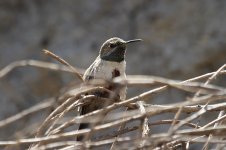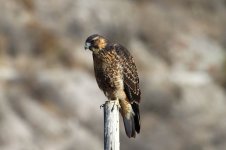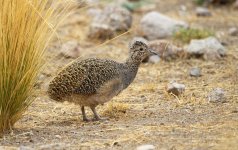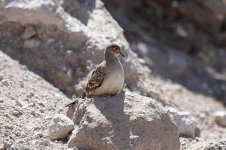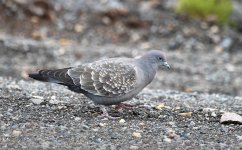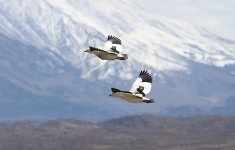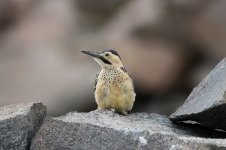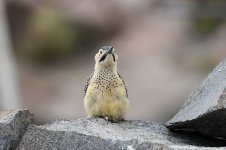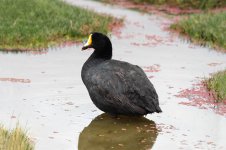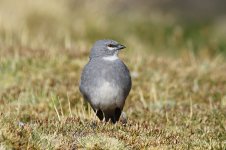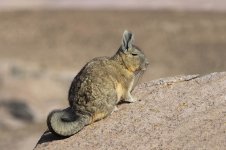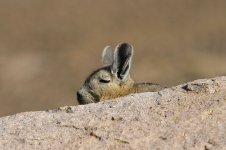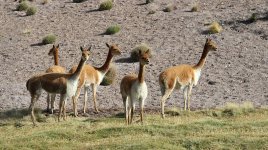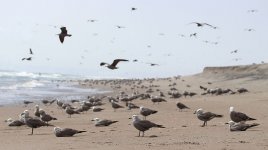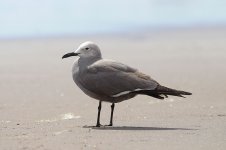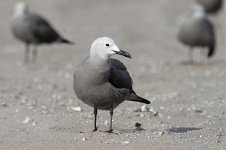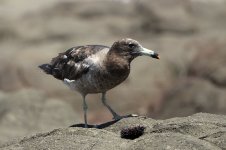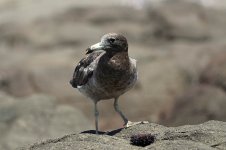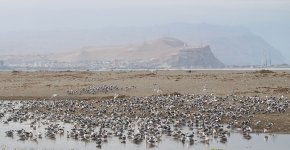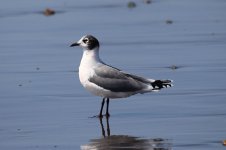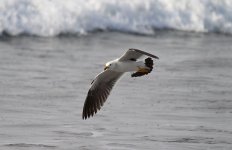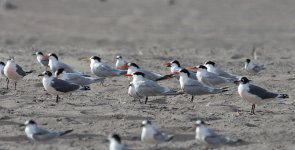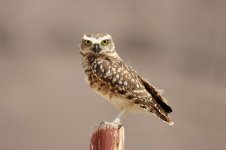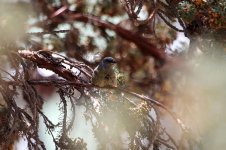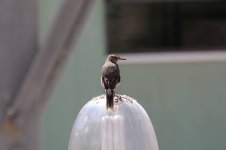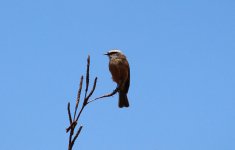
-
Welcome to BirdForum, the internet's largest birding community with thousands of members from all over the world. The forums are dedicated to wild birds, birding, binoculars and equipment and all that goes with it.
Please register for an account to take part in the discussions in the forum, post your pictures in the gallery and more.
You are using an out of date browser. It may not display this or other websites correctly.
You should upgrade or use an alternative browser.
You should upgrade or use an alternative browser.
Chile, Land of Condors and King Penguins (1 Viewer)
- Thread starter Jos Stratford
- Start date
More options
Who Replied?
31 December. Lauca National Park.
High altitude day, most of our time between 4500 m and 4700 m. Hard going physically with fatigue and headaches from almost moment one as we stopped at a marsh known to hold Diameded Sandpiper-Plover. Though I had seen them at El Yeso, this felt like it had been eons before, so I would have been quite happy to encounter more. Moreover however, this was also the lands of Viscacha, an animal I much desired to see, a weird rabbit-like beastie with big floppy ears and a long tail. And easy they proved to be, a whole colony of them residing on a rocky outcrop above the marsh. In temperatures a degree or two below freezing, these great little animals were all slumbering across the boulders catching the first rays of the morning sun, not in the least bit concerned by sudden human intrusion and quite tame indeed. Seeing these, little one found a good burst of energy and was soon climbing all over the rocks to find more.
I left her to it and went to explore the marsh. Didn't find Diameded Sandpiper-Plover, but excellent it was – two Rufous-bellied Seedsnipe amongst the highlights, plus several of the smaller Grey-breasted Seedsnipe, along with Puna Snipe, no shortage of both White-fronted Ground-Tyrant and Puna Tyrant, lots of Cream-winged Cinclodes, my first and only White-winged Cinclodes and several Andean Negrito. Back at the rock outcrop, photographed the Viscacha and a pair of White-winged Duica-Fiches, seeing also pair of White-throated Duica-Finches. Vicuma, the northern relative of the Guanico seen in Patagonia, roamed the opposite slopes, a little rodent scurried across which appeared to be a Bolivian Pericote.
Onward and upward, inducing more fatigue, next stop was at a set of wetlands adjacent to a police checkpoint. Flocks of flamingoes dotted distant pools, congregations of wildfowl there too. My little companion was definitely the worse for wear and opted to sleep in the car while I set off for the pools. Wasn't a big effort walking across the flat plain, but the slightest elevation certainly was. Passed the first small pools, Giant Coots and Puna Teals on the still waters, Andean Avocet and Andean Gulls the latest additions. Scanning across, could see hundreds of Andean Geese, many flying to snow-capped backdrops. Almost surely, Puna Plover would be out there somewhere, not to mention the three flamingo species, but my energy levels were decidedly low ...I opted for the lazy approach and returned to explore further by car. Most flamingoes stuck to the pools far away, but one particularly cooperative group had thoughtfully decided to settle upon a roadside pool ...and there, at least 100 Chilean Flamingoes, 60 Andean Flamingoes and 30 James's Flamingoes,the full set on one pool, nice! Hundreds of Speckled Teal and Puna Teal, dozens of Giant Coots, flights of Puna Ibis, four Andean Lapwings, the list of birds went on and on. Our health went down. Took a poor condition road to Laguna Cotacotani, hoped to see Puna Plover here, but didn't see much at all, bar more Viscacha. Returned and stopped in Parinacota village – didn't expect anything here, but was pleasantly surprised ...in addition to a bunch of armed troops suddenly materializing, I encountered not only my only Golden-spotted Ground-Doves of the trip, but my only Andean Flicker too, a superb individual hopping about on a wall in the village centre!
The troops departed, we departed, climbing further again to Lake Changara, a vast shallow pool right on the Bolivian border. Amazing queue of trucks waiting to cross the border, many kilometres of them, all stationary with drivers out and sitting on rocks, chatting, etc. Glad I wasn't in that queue, the few cars that venture up here allowed to zip by without waiting. As for Lake Changara, the fringes were full of birds – hundreds upon hundreds of Giant Coots and Andean Coots, many dozens of Silvery Coots, a good mix of Crested Ducks, Puna Teal and undoubtedly other species too. Andean Gulls flocked to grab titbits from the bored truck drivers tossing morsels their way. This site honestly deserved a much better visit than I gave it, but my younger companion seemed to be fading rather fast, now without the basic energy to even sit up. Not wishing to transport a dead person back down the mountain, I thought it prudent to respect the perils of altitude sickness and begin a descent. Added Black Siskins on the way down, a flock of six and a single, plus three Puna Miners and another flock of Spot-winged Pigeons, but otherwise made few spots.
In my haste, I passed a small ground-tyrant on a fence and paused only long enough to take a photograph and think 'hmm, that is a odd one'. Looking at the picture, it still looks odd ...closest match seems Spot-billed Ground-Tyrant, but it doesn't appear to have to pale spot on the bill!
Decided on a full descent, driving all the way back to the coast. Amazing road, not least for the number of trucks and cars that don't make it – with near non-stop hairpins, drops to gorges below and a near complete lack of safety barriers, wreckage of vehicles that had gone over was a pretty common site, little rock piles dotting the roadside often every few hundred metres, standing as memorials to lost lives. As we descended and oxygen levels returned to normal, headaches vanished, energy levels soared.
Returned to our hotel just as the sun was setting, popped into town to celebrate New Year's Eve, McDonald's again I have to admit. Chileans were beginning to crowd onto the streets, we opted to skip the revelry (or rather I did, she wanted to be on the streets to mark the New Year in). Was fast asleep by the midnight hour.
High altitude day, most of our time between 4500 m and 4700 m. Hard going physically with fatigue and headaches from almost moment one as we stopped at a marsh known to hold Diameded Sandpiper-Plover. Though I had seen them at El Yeso, this felt like it had been eons before, so I would have been quite happy to encounter more. Moreover however, this was also the lands of Viscacha, an animal I much desired to see, a weird rabbit-like beastie with big floppy ears and a long tail. And easy they proved to be, a whole colony of them residing on a rocky outcrop above the marsh. In temperatures a degree or two below freezing, these great little animals were all slumbering across the boulders catching the first rays of the morning sun, not in the least bit concerned by sudden human intrusion and quite tame indeed. Seeing these, little one found a good burst of energy and was soon climbing all over the rocks to find more.
I left her to it and went to explore the marsh. Didn't find Diameded Sandpiper-Plover, but excellent it was – two Rufous-bellied Seedsnipe amongst the highlights, plus several of the smaller Grey-breasted Seedsnipe, along with Puna Snipe, no shortage of both White-fronted Ground-Tyrant and Puna Tyrant, lots of Cream-winged Cinclodes, my first and only White-winged Cinclodes and several Andean Negrito. Back at the rock outcrop, photographed the Viscacha and a pair of White-winged Duica-Fiches, seeing also pair of White-throated Duica-Finches. Vicuma, the northern relative of the Guanico seen in Patagonia, roamed the opposite slopes, a little rodent scurried across which appeared to be a Bolivian Pericote.
Onward and upward, inducing more fatigue, next stop was at a set of wetlands adjacent to a police checkpoint. Flocks of flamingoes dotted distant pools, congregations of wildfowl there too. My little companion was definitely the worse for wear and opted to sleep in the car while I set off for the pools. Wasn't a big effort walking across the flat plain, but the slightest elevation certainly was. Passed the first small pools, Giant Coots and Puna Teals on the still waters, Andean Avocet and Andean Gulls the latest additions. Scanning across, could see hundreds of Andean Geese, many flying to snow-capped backdrops. Almost surely, Puna Plover would be out there somewhere, not to mention the three flamingo species, but my energy levels were decidedly low ...I opted for the lazy approach and returned to explore further by car. Most flamingoes stuck to the pools far away, but one particularly cooperative group had thoughtfully decided to settle upon a roadside pool ...and there, at least 100 Chilean Flamingoes, 60 Andean Flamingoes and 30 James's Flamingoes,the full set on one pool, nice! Hundreds of Speckled Teal and Puna Teal, dozens of Giant Coots, flights of Puna Ibis, four Andean Lapwings, the list of birds went on and on. Our health went down. Took a poor condition road to Laguna Cotacotani, hoped to see Puna Plover here, but didn't see much at all, bar more Viscacha. Returned and stopped in Parinacota village – didn't expect anything here, but was pleasantly surprised ...in addition to a bunch of armed troops suddenly materializing, I encountered not only my only Golden-spotted Ground-Doves of the trip, but my only Andean Flicker too, a superb individual hopping about on a wall in the village centre!
The troops departed, we departed, climbing further again to Lake Changara, a vast shallow pool right on the Bolivian border. Amazing queue of trucks waiting to cross the border, many kilometres of them, all stationary with drivers out and sitting on rocks, chatting, etc. Glad I wasn't in that queue, the few cars that venture up here allowed to zip by without waiting. As for Lake Changara, the fringes were full of birds – hundreds upon hundreds of Giant Coots and Andean Coots, many dozens of Silvery Coots, a good mix of Crested Ducks, Puna Teal and undoubtedly other species too. Andean Gulls flocked to grab titbits from the bored truck drivers tossing morsels their way. This site honestly deserved a much better visit than I gave it, but my younger companion seemed to be fading rather fast, now without the basic energy to even sit up. Not wishing to transport a dead person back down the mountain, I thought it prudent to respect the perils of altitude sickness and begin a descent. Added Black Siskins on the way down, a flock of six and a single, plus three Puna Miners and another flock of Spot-winged Pigeons, but otherwise made few spots.
In my haste, I passed a small ground-tyrant on a fence and paused only long enough to take a photograph and think 'hmm, that is a odd one'. Looking at the picture, it still looks odd ...closest match seems Spot-billed Ground-Tyrant, but it doesn't appear to have to pale spot on the bill!
Decided on a full descent, driving all the way back to the coast. Amazing road, not least for the number of trucks and cars that don't make it – with near non-stop hairpins, drops to gorges below and a near complete lack of safety barriers, wreckage of vehicles that had gone over was a pretty common site, little rock piles dotting the roadside often every few hundred metres, standing as memorials to lost lives. As we descended and oxygen levels returned to normal, headaches vanished, energy levels soared.
Returned to our hotel just as the sun was setting, popped into town to celebrate New Year's Eve, McDonald's again I have to admit. Chileans were beginning to crowd onto the streets, we opted to skip the revelry (or rather I did, she wanted to be on the streets to mark the New Year in). Was fast asleep by the midnight hour.
Last edited:



1 January. Arica & Chaca Valley.
New Year's Day, what better way to kick the year off than to explore the northern beaches of Arica where I had seen the vast flocks of gulls and terns congregating. And was it good – not only many thousands of gulls on the beach, but an unexpected top class lagoon on the landward side too. This was a bonus indeed, I did not know that this existed. Not massive in size, but the slither of water certainly produced a good range of birds, especially of Nearctic waders spending the northern winter down here.
Parked adjacent, Peruvian Meadowlarks were amongst the first birds, about a dozen singing from bushtops in the damp stuff, Slender-billed Finches also in this general area. Skirted around the one end of the pool, then slowly walked along the beach, gulls to the one side, the pool to the other. It was an impressive setting, perhaps 20,000 Grey Gulls lining the beach ridge, about 3000 Elegant Terns in clusters amongst them. Also a couple of hundred Band-tailed Gulls and, hogging the edge of the pool, some 1800 Franklin's Gulls. Slightly misty this morning and the sea basically flat, I scanned a few times for a possible Pomarine Skua or something ...what I was not expecting was a largish long-winged petrel meandering just off the beach, looping its way north. Totally unexpected, a Markham's Storm Petrel! Ten minutes later another passed north, this one actually flying up the beach itself and briefly over the pool!
And as for the pool, very nice indeed – fourteen species of Nearctic waders, including no less than 140 Grey Plovers, 45 American Golden Plovers, four Killdeers, at least 25 Semipalmated Plovers, 20 Semipalmated Sandpipers and six Least Sandpipers, all being my only sightings of the species in Chile. Also Black Skimmer, Snowy Egrets and Little Blue Heron, about 25 Black-crowned Night Herons and a Puna Ibis. Amongst this lot, my only Cinnamon Teals and White-cheeked Pintails of the trip as well, along with Inca Terns offshore and a grand 450 or so Turkey Vultures loitering on the beach. New Year Party indeed!
By 10.00 a.m., with the sun now breaking through the mist, I was already on over 50 species, a localised Peruvian Martin one of the final species before I decided to break for a rare breakfast. Passed back through Arica town, plenty of revelers still ambling back from their all-night parties.
Had hoped to find a Tamarugo Conebill later in the day, driving the 60 km to the hyper-arid Chaca Valley. Totally failed on this, walking quite some kilometres in rather high temperatures and little shade. Had further possibilities of Chilean Woodstar here too, but also didn't see. We did however have a rather stunning pair of Burrowing Owls that sat staring at us, plus lots of Peruvian White-crested Eleanias and my only Bran-coloured Flycatcher of the day. In the heat and dust, eventually gave up and returned to Arica for a little siesta and beach time (ie little one paddling, me gull watching, etc), Also had a short walk around the Isla del Alacran, adding super close range Surfbirds and Ruddy Turnstones and, after another stroll at the lagoon (adding no new species), went back to the hotel for a while to await dark.
Spotlighting in the Lutra Valley from dusk, randomly taking small roads though the agricultural plains. Only gave it a couple of hours, one Band-tailed Nightjar flying, two Peruvian Thick-knees calling. And so ended the 1 January, 71 species for the day, heavily dominated by wetland species.
New Year's Day, what better way to kick the year off than to explore the northern beaches of Arica where I had seen the vast flocks of gulls and terns congregating. And was it good – not only many thousands of gulls on the beach, but an unexpected top class lagoon on the landward side too. This was a bonus indeed, I did not know that this existed. Not massive in size, but the slither of water certainly produced a good range of birds, especially of Nearctic waders spending the northern winter down here.
Parked adjacent, Peruvian Meadowlarks were amongst the first birds, about a dozen singing from bushtops in the damp stuff, Slender-billed Finches also in this general area. Skirted around the one end of the pool, then slowly walked along the beach, gulls to the one side, the pool to the other. It was an impressive setting, perhaps 20,000 Grey Gulls lining the beach ridge, about 3000 Elegant Terns in clusters amongst them. Also a couple of hundred Band-tailed Gulls and, hogging the edge of the pool, some 1800 Franklin's Gulls. Slightly misty this morning and the sea basically flat, I scanned a few times for a possible Pomarine Skua or something ...what I was not expecting was a largish long-winged petrel meandering just off the beach, looping its way north. Totally unexpected, a Markham's Storm Petrel! Ten minutes later another passed north, this one actually flying up the beach itself and briefly over the pool!
And as for the pool, very nice indeed – fourteen species of Nearctic waders, including no less than 140 Grey Plovers, 45 American Golden Plovers, four Killdeers, at least 25 Semipalmated Plovers, 20 Semipalmated Sandpipers and six Least Sandpipers, all being my only sightings of the species in Chile. Also Black Skimmer, Snowy Egrets and Little Blue Heron, about 25 Black-crowned Night Herons and a Puna Ibis. Amongst this lot, my only Cinnamon Teals and White-cheeked Pintails of the trip as well, along with Inca Terns offshore and a grand 450 or so Turkey Vultures loitering on the beach. New Year Party indeed!
By 10.00 a.m., with the sun now breaking through the mist, I was already on over 50 species, a localised Peruvian Martin one of the final species before I decided to break for a rare breakfast. Passed back through Arica town, plenty of revelers still ambling back from their all-night parties.
Had hoped to find a Tamarugo Conebill later in the day, driving the 60 km to the hyper-arid Chaca Valley. Totally failed on this, walking quite some kilometres in rather high temperatures and little shade. Had further possibilities of Chilean Woodstar here too, but also didn't see. We did however have a rather stunning pair of Burrowing Owls that sat staring at us, plus lots of Peruvian White-crested Eleanias and my only Bran-coloured Flycatcher of the day. In the heat and dust, eventually gave up and returned to Arica for a little siesta and beach time (ie little one paddling, me gull watching, etc), Also had a short walk around the Isla del Alacran, adding super close range Surfbirds and Ruddy Turnstones and, after another stroll at the lagoon (adding no new species), went back to the hotel for a while to await dark.
Spotlighting in the Lutra Valley from dusk, randomly taking small roads though the agricultural plains. Only gave it a couple of hours, one Band-tailed Nightjar flying, two Peruvian Thick-knees calling. And so ended the 1 January, 71 species for the day, heavily dominated by wetland species.




2 January. Roads of Death.
Not for the faint-hearted are Chile's roads in the high Andes. Travelling the Arica to Lauca highway, a key transit route for landlocked Bolivia, is a somewhat sombre experience - as it winds and climbs, so too does the number of roadside memorials increase, many just a few hundred metres apart, each a testament to yet another car or truck that has plunged into a canyon or ended up as a crumpled heap against rocks. At least however this road has asphalt - the minor roads are even worse, one particularly notorious stretch across the border in Bolivia once seeing 200-300 persons die annually on a mere 70 km of road!
Anyhow, up we were going - our plan to drive as far as Zapahuira, then take a minor road south to Belen and its remnant Polylepis forest. Asphalt all the way. Except it wasn't! As we reached El Tambo, the road was closed, a few cars parked at a barrier across the road. Spoke with a Bolivian in a landcruiser, "closed till midday, road repairs". He knew another way, I opted to follow. Rough rocky track, narrow, loose gravel, steep slopes, so safety barriers whatsoever ...and, icing on the cake, big drops to the one side, a wall of rocks on the other! Keeps you on your toes, truly an intense experience, kilometre after kilometre of knowing that one slip could well be fatal. Remains of cars far down the slope on several occasions, then a truck and car stopped on a sharp corner. Ropes attached to the truck, guys edging down the slope. We stopped. Better we hadn't - a white car had just gone off, tumbled perhaps 400 metres down a steep scree slope and was now a smashed up wreck. All dead. Images of the last moments flooded my head, can't be a good way to go. Onward we went, a bit silent for a while, the drive was even more intense now.
Got back to the main road without incident, continued towards Belen. Nice stop a little before Chapiquiña, a Blue-and-yellow Tanager in streamside trees, Black-throated Flowerpecker and Canyon Canastero also here, plus two Black-billed Shrike-Tyrants in a small electricity sub-station. Some kilometres on, reached the Polylepis forest at Belen. High altitude again, 3800 m, so fatigue was again an issue, as was heat this day. Two main targets - Giant Conebill and the D’Orbigny’s Chat-Tyrant, both very localised species. Clambered around for a couple of hours, splendid views of the D’Orbigny’s Chat-Tyrant, but no sign of Giant Conebill. I guess I should have been here at dawn. Also saw Streaked Tit-Spinetails, Black-headed Sierra-Finches, numerous Mourning Sierra-Finches, both Black Siskin and Hooded Siskin and a good variety of other common species.
With an evening flight from Arica, we eventually decided it was time to descend. Made the mistake of taking an alternative route - rocky and narrow most of the way, gravel not asphalt and drops to the sides again. No way I could average much above 30 km/hour ...more hours of intense concentration, wondering too if we would make it back in time for the flight. Some good birds to add distractions, the highlights a Sparkling Violetear and another flock of Spot-winged Doves.
Midway, fortunately, the road improved considerably ...up went the speed, though those drops and roadside memorials continued to scream caution. Eventually got back to Arica, a sudden wave of nausea hitting me like a brick. Stopped by the sea and for near 30 minutes felt physically ill, even struggling to breathe. Perhaps a sudden release of adrenalin, maybe mixed with some impact of the day's high altitude, I certainly have never experienced anything like that before! Forced some hot tea down my throat, headed for the airport. Late evening, still not feeling exactly brilliant, we boarded a flight for Santiago. Back in the capital, checked into a hotel near the airport. What an amazing day!
Not for the faint-hearted are Chile's roads in the high Andes. Travelling the Arica to Lauca highway, a key transit route for landlocked Bolivia, is a somewhat sombre experience - as it winds and climbs, so too does the number of roadside memorials increase, many just a few hundred metres apart, each a testament to yet another car or truck that has plunged into a canyon or ended up as a crumpled heap against rocks. At least however this road has asphalt - the minor roads are even worse, one particularly notorious stretch across the border in Bolivia once seeing 200-300 persons die annually on a mere 70 km of road!
Anyhow, up we were going - our plan to drive as far as Zapahuira, then take a minor road south to Belen and its remnant Polylepis forest. Asphalt all the way. Except it wasn't! As we reached El Tambo, the road was closed, a few cars parked at a barrier across the road. Spoke with a Bolivian in a landcruiser, "closed till midday, road repairs". He knew another way, I opted to follow. Rough rocky track, narrow, loose gravel, steep slopes, so safety barriers whatsoever ...and, icing on the cake, big drops to the one side, a wall of rocks on the other! Keeps you on your toes, truly an intense experience, kilometre after kilometre of knowing that one slip could well be fatal. Remains of cars far down the slope on several occasions, then a truck and car stopped on a sharp corner. Ropes attached to the truck, guys edging down the slope. We stopped. Better we hadn't - a white car had just gone off, tumbled perhaps 400 metres down a steep scree slope and was now a smashed up wreck. All dead. Images of the last moments flooded my head, can't be a good way to go. Onward we went, a bit silent for a while, the drive was even more intense now.
Got back to the main road without incident, continued towards Belen. Nice stop a little before Chapiquiña, a Blue-and-yellow Tanager in streamside trees, Black-throated Flowerpecker and Canyon Canastero also here, plus two Black-billed Shrike-Tyrants in a small electricity sub-station. Some kilometres on, reached the Polylepis forest at Belen. High altitude again, 3800 m, so fatigue was again an issue, as was heat this day. Two main targets - Giant Conebill and the D’Orbigny’s Chat-Tyrant, both very localised species. Clambered around for a couple of hours, splendid views of the D’Orbigny’s Chat-Tyrant, but no sign of Giant Conebill. I guess I should have been here at dawn. Also saw Streaked Tit-Spinetails, Black-headed Sierra-Finches, numerous Mourning Sierra-Finches, both Black Siskin and Hooded Siskin and a good variety of other common species.
With an evening flight from Arica, we eventually decided it was time to descend. Made the mistake of taking an alternative route - rocky and narrow most of the way, gravel not asphalt and drops to the sides again. No way I could average much above 30 km/hour ...more hours of intense concentration, wondering too if we would make it back in time for the flight. Some good birds to add distractions, the highlights a Sparkling Violetear and another flock of Spot-winged Doves.
Midway, fortunately, the road improved considerably ...up went the speed, though those drops and roadside memorials continued to scream caution. Eventually got back to Arica, a sudden wave of nausea hitting me like a brick. Stopped by the sea and for near 30 minutes felt physically ill, even struggling to breathe. Perhaps a sudden release of adrenalin, maybe mixed with some impact of the day's high altitude, I certainly have never experienced anything like that before! Forced some hot tea down my throat, headed for the airport. Late evening, still not feeling exactly brilliant, we boarded a flight for Santiago. Back in the capital, checked into a hotel near the airport. What an amazing day!
Last edited:


3 January. The Finale.
Final day, woke to a hot sunny Santiago ...opted out of any last mad dashes anywhere in favour of a relaxed breakfast at the hotel, Eared Doves in scrubby stuff just adjacent. Over at the airport, Southern Lapwings on lawns near the terminal, Chilean Swallows and Chilean Hawk in the same area, our final farewell birds. Boarded an Iberian Airlines flight for the 12 hours to Madrid, connecting onward to London and, after a night in the terminal, to Vilnius.
Trip over.
Final day, woke to a hot sunny Santiago ...opted out of any last mad dashes anywhere in favour of a relaxed breakfast at the hotel, Eared Doves in scrubby stuff just adjacent. Over at the airport, Southern Lapwings on lawns near the terminal, Chilean Swallows and Chilean Hawk in the same area, our final farewell birds. Boarded an Iberian Airlines flight for the 12 hours to Madrid, connecting onward to London and, after a night in the terminal, to Vilnius.
Trip over.
stuartvine
Well-known member
Fantastic report Jos - another trip to add to my bucket list!

Fantastic report Jos - another trip to add to my bucket list!
Many thanks, have to say that Chile did impress me ...ranks right up there amongst the best countries I have ever visited.
foresttwitcher
Virtually unknown member

It is an overused word but I think awesome sums it up.
Users who are viewing this thread
Total: 2 (members: 0, guests: 2)




